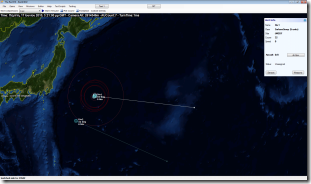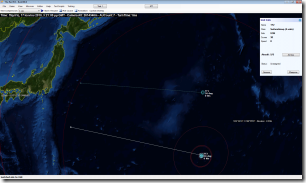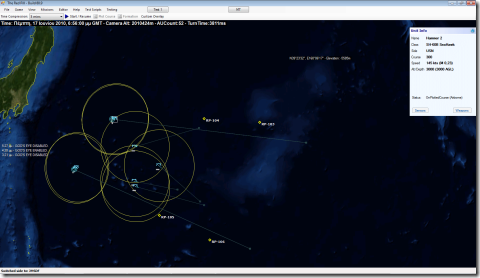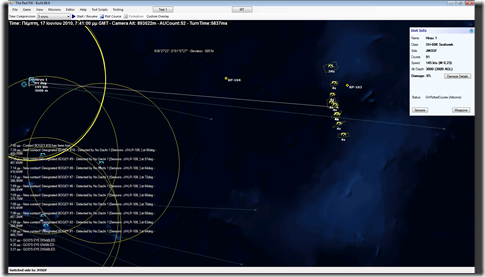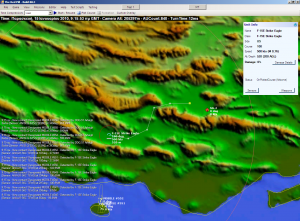Red Pill screenshots #3: Cans Only – Part I
A new series of screenshots from The Red Pill, the new air/naval wargame under development at Warfare Sims, have been released from the internal testing team along with commentary.
The screenshots were taken while testing out a new scenario called “Cans Only”. From the scenario description:
This is a simple ASuW-centered scenario addressing a hypothetical surface engagement exercise in the western Pacific in the summer of 2010. Two USN surface action groups, one of them including the amphibious ship USS Essex, must reach the Tokyo-Yukosuka area. Two JMSDF taskgroups act as OPFOR and must prevent them from doing so. There is no land-based air support or submarines; both sides must make do with their surface ships and what they can carry onboard. The Japanese have an advantage in numbers, but the US has more Aegis ships and lots more helicopters. The setup is 2-on-2 groups so there are plenty of decisions to make!
First two screens are the starting setups of each side (click for full size). Notice that, even though the tactical display is in group-mode, by selecting a group we can see its member units and their weapon/sensor range rings dimmed out. This is a feature long (more than a decade long!) requested by the air/naval wargaming community, and Red Pill is the first to deliver on it.
The Japanese player opens the OOB window to get a better feel of the composition & disposition of his assets. By click-selecting any unit in the OOB window, the map centers and focuses on that unit. This makes it easy to find a desired unit to control without having to remember where it is located. The OOB window can also list the units grouped by the mission to which they are assigned. 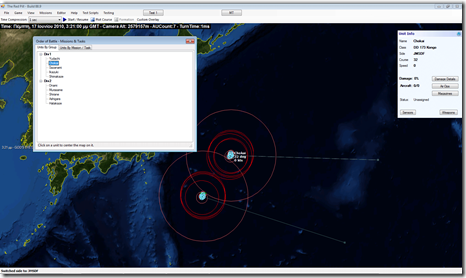
The Japanese player has laid out a patrol area for his helicopters (marked by reference points 104 to 106). Patrols in areas demarcated by reference points are not a new idea in air/naval wargames, but Red Pill adds some important new features:
- Any reference point can be anchored to any map unit (friendly or otherwise) and maintain a constant range & bearing from it. This allows the creation of truly “mobile” patrol areas/screens, exclusion zones, threat zones etc. In this case, the JMSDF player has anchored the patrol area’s reference points to the center of his northern taskgroup, so whichever way the group moves, the patrol area will automatically adjust its location relative to it.
- Units assigned to such mobile patrol areas are not restricted to the group’s own assets but may include any friendly unit. If the JMSDF player had available P-3s in any nearby airbase, for example, he could have assigned them to the same patrol area as the helicopters of his surface group.
The helicopter patrol is beginning to bear results. A string of helicopter contacts are passively detected by the ESM gear on the Japanese helicopters and surface ships. The USN player has been a bit careless in organizing his own helo patrols and may unknowingly give his JMSDF adversary a hint about the location of at least some of his ships.
The USN player suspects he may be already detected and decides to do a weapons check on one of his prime combatants, the cruiser Port Royal. Plenty of firepower (including a bunch of SM-3s) and all systems operational. Whatever comes, she’s ready.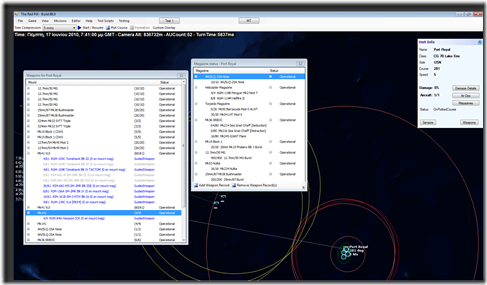
More screenshots from the same scenario to follow soon.
PAK-FA: Preliminary analysis
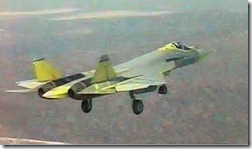 Defence aviation oldtimer Bill Sweetman has been quick to trot out an interesting preliminary report based on the photos/videos of the PAK-FA’s first flight.
Defence aviation oldtimer Bill Sweetman has been quick to trot out an interesting preliminary report based on the photos/videos of the PAK-FA’s first flight.
You know you’ve got some good stuff to read when the analysis begins like this:
First of all, for anyone contemplating the use of the word "Raptorski": don’t. While this is an airplane that could have been the answer to the Advanced Tactical Fighter requirement, way back when, it’s not an F-22 in many important ways.
Definitely a recommended read.
PAK-FA first flight
Sukhoi has conducted the first flight of its prototype PAK FA fifth-generation fighter, with the aircraft having conducted a 47min sortie this morning.
[…]The PAK FA is powered by two NPO Saturn "Item 117" engines, developed from the Item 117S design already flown on Sukhoi’s Su-35 and a Su-27M testbed. The experimental aircraft’s integrated flight control system controls the engines, along with all other major systems.
Sukhoi says other key design elements include the use of composite materials, advanced aerodynamic techniques and measures to reduce the aircraft’s engine signature, which it claims results in an “unprecedented small radar cross section in radar, optical and infrared range”. The PAK FA is also equipped with an advanced phased-array antenna radar, it adds. Russia’s Tikhomirov NIIP displayed an active electronically scanned array design for the fighter at last year’s Moscow MAKS air show.
[…]The first stage of flight trials involving the PAK FA prototype will last until 2012, when the Russian defence ministry and air force are expected to decide on the future of the project.
|
|
|
And you thought this stuff happens only in technothrillers
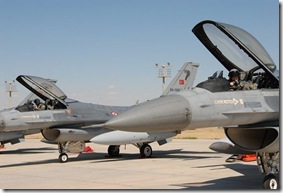 As they say, truth is often stranger than fiction:
As they say, truth is often stranger than fiction:
The plan was based on creating tension with Greece that could lead to a conflict.
The details of the plan went as far as to include the idea of allowing a Turkish fighter aircraft to crash as a result of direct Greek action. Taraf newspaper reports that the plan was set up by 162 officers of the Turkish armed forces of which 29 were high level officers.
Of course, there is also the possibility that this is a deliberate leak by the Turkish armed forces in order to discourage HAF pilots from blasting THK’s airspace violators out of the Aegean sky. Wouldn’t be the first time that psyops are employed to compensate for a military disadvantage (e.g. Imia crisis).
Red Pill Screenshots #2
Two more screenshots from the Red Pill project are now available, each showcasing different aspects of this air/naval wargame (click pics for full-size view):
Here we see how a single A. Burke-class destroyer positioned in the Arabian Sea is able to threaten a wide range of Iranian targets with its Tomahawk cruise missiles (dark red range ring). The map view is deliberately zoomed out to display the globe.
Early on in the beginning of development, it was decided to use a Google Earth-style, virtual globe interface for the Red Pill. According to the developers it was a difficult technical choice, but a worthwhile one because it solves several longstanding issues present in other similar wargames:
* No map distortions (squatted range rings etc.) at all, since the view is “natural”: the player observes the theater from an overhead satellite-like viewpoint.
* It is possible to have truly global-scale scenarios without any map restrictions. For example, in the above picture there is concurrently a carrier battlegroup transiting the entire Pacific ocean, hidden of course from view.
* Scenario authors can easily create polar-centric scenarios. The North Pole area in particular is essential for any serious Cold War Gone Nuclear scenario (think “WarGames”), and the gradual opening of sea lanes in the Arctic is already making this area one of the strategically “hottest” places in the forthcoming decades.
In addition, the virtual globe interface supports an arbitrary number of map layers (shown here is NASA’s Blue Marble) for things like land elevation, water depth, weather data etc. so that players and scenario authors alike can customize their map preferences to the situation at hand. Moreover, additional custom images can be overlaid on any portion of the map for extra fidelity if required.
Here an F-15E Strike Eagle gets down and dirty, following a low-altitude terrain-masking course around the Zagros mountains in the Iranian coast en route to attack a SA-2 site. Here we are using the terrain-relief map layer in order to clearly depict terrain elevations and exploit them for planning the penetration ingress.
By default, the Red Pill uses terrain & bathymetry data of vastly higher detail than any previous similar wargames. Furthermore, the effects of terrain are significantly more influential in everything from unit navigation to physics to weapon & sensor functions to AI etc.
For example, sensors are affected not only by line-of-sight (which is again far more detailed than any past implementation) but also by the different clutter coefficients of the land & sea environment. Trying to pick out a surface target upon a calm sea is one thing; detecting the very same target amidst stormy waves is tougher, and overland detection is another ball game altogether. In another example, line-of-sight blockage can not only prevent broad search detection but also ruin an ongoing engagement; the real-world tactic of detecting an incoming SAM and ducking behind a ridge to break lock is perfectly doable in RP.
The Red Pill’s terrain can be your best ally if you use it wisely – or your worst enemy if you don’t.




